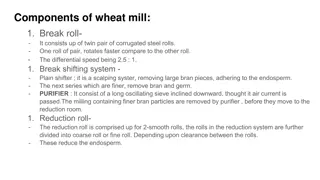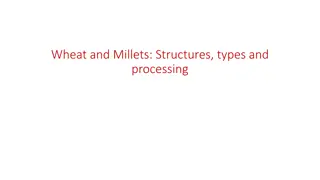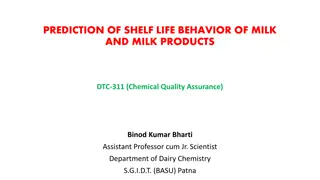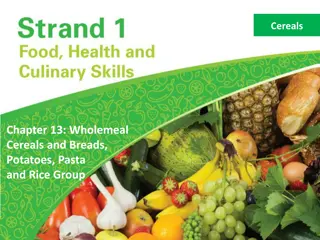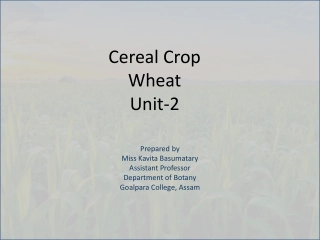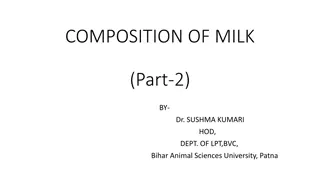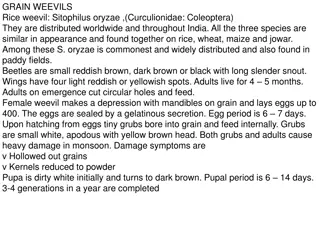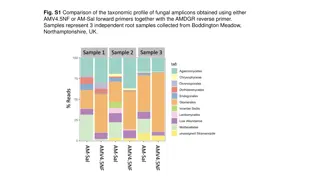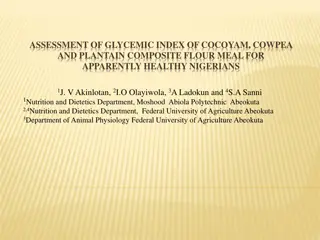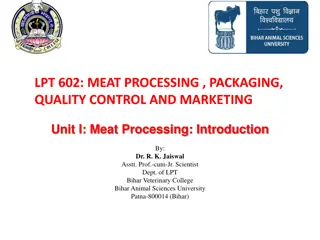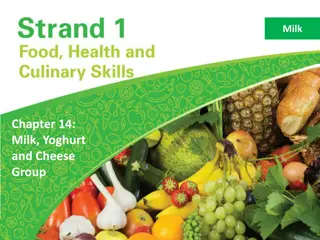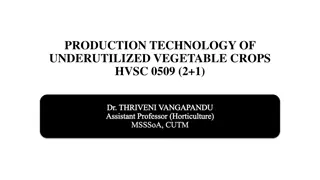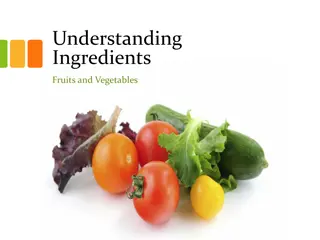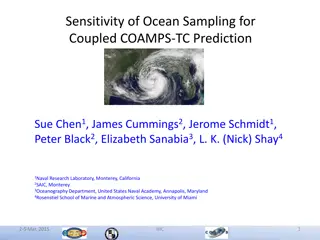Nutritive Value and Shelf Life Study of Wheat and Dasheen Flour Sweetbread
This study compared the nutritive value of sweetbread made from dasheen flour and wheat flour, focusing on sensory characteristics, shelf life evaluation, and treatment preferences. Processing methods, sensory evaluation sessions, physiochemical and microbiological analyses, and statistical procedures were conducted to assess the quality and preferences of the sweetbread variations over a period of 5 to 10 days. The W-70:T-30 treatment emerged as the most preferred option based on sensory evaluations.
Download Presentation

Please find below an Image/Link to download the presentation.
The content on the website is provided AS IS for your information and personal use only. It may not be sold, licensed, or shared on other websites without obtaining consent from the author. Download presentation by click this link. If you encounter any issues during the download, it is possible that the publisher has removed the file from their server.
E N D
Presentation Transcript
Ref. No. A03 SHELF LIFE STUDY, SENSORY EVALUATION AND NUTRITIVE VALUE OF WHEAT FLOUR/ DASHEEN (Colocasia esculenta (L.) Schott) Taro/Cocoyam FLOUR SWEETBREAD Maltee R. Rampat, Marsha Singh, Neela Badrie Department of Food Production Faculty of Food and Agriculture The University of the West Indies, St Augustine IConETech-2020, Faculty of Engineering, The UWI, St. Augustine, Trinidad and Tobago
INTRODUCTION Flour derived from wheat contain gluten (Wheatenmeal Act, 1956 section 3 (1) (2018). Taro/dasheen is a staple food high in carbohydrates and can be found throughout the Pacific Islands and worldwide. Taro corms and cormels may be processed into flour (Onyeike et al. 1995). Taro flour makes part of the new types of flour (Njintang and Mbofung 2003). Taro flour percentages can be used to replace wheat flour to produce dasheen sweetbread that is superior (nutritionally) than sweetbread made of 100%wheat flour. IConETech-2020, Faculty of Engineering, The UWI, St. Augustine, Trinidad and Tobago
OBJECTIVES To compare the nutritive value of the dasheen sweetbread with the control wheat flour. To determine sensory characteristics such as appearance, taste, mouth feel, colour, texture and overall quality and the preferred variation of sweetbread by conducting sensory evaluation with untrained panelists To evaluate the products over a period of five to ten days physically, microbiologically and chemically To evaluate the shelf life of the product under air conditioned/cool air at 20 C IConETech-2020, Faculty of Engineering, The UWI, St. Augustine, Trinidad and Tobago
METHODOLOGY 1. Processing of dasheen (taro flour) 2. Preparation of Wheat - Taro sweetbreads 3. Focusgroupsession 4. Sensory Evaluation and Acceptance Control (W-100: T-0) and (W-70: T-30) Hedonic Scale and Food Action Rating Scale IConETech-2020, Faculty of Engineering, The UWI, St. Augustine, Trinidad and Tobago
METHODOLOGY METHODOLOGY 5. Treatments and Shelf Life Study: - Physiochemical: texture, colour, water activity, pH, ash, moisture, fibre, protein, dry matter, fat and carbohydrates - Microbiological: PCA and PDA (bacteria, yeast and mould) 5 to 10 days study. Treatments stored at 20 C for daily observation of deterioration, for 10 consecutive days - 6. Statistical analysis: - Mean scores and Standard Deviation, - Descriptive Statistics and one way Anova IConETech-2020, Faculty of Engineering, The UWI, St. Augustine, Trinidad and Tobago
RESULTS Focus group session W-70: T-30 treatment was most preferred amongst the three variations of composite sweetbread due to taste and texture IConETech-2020, Faculty of Engineering, The UWI, St. Augustine, Trinidad and Tobago
RESULTS Table 1:Proximate evaluation of four sweetbread treatments Parameters (g/100) W-100: T-0 W-70: T-30 W-60: T-40 W-50: T-50 P value Moisture content 2.49 0.004 3.5 1.6 2.6 0.02 2.92 0.09 0.642 Ash content 17.1 0.07 18.06 0.1 18.10 0.3 20.4 0.08 0.000 Either Extract 127.2 0.51 134.2 2.5 115.9 0.65 101.0 2.41 0.000 Crude Fibre 13.6 0.3 16.0 0.05 13.2 0.08 11.8 0.11 0.000 Crude protein 77.2 2.2 59.7 2.1 56.2 1.4 52.8 1.4 0.001 Carbohydrates 765.9 2.7 774.2 2.7 794.8 6.8 810.5 5.5 0.001 IConETech-2020, Faculty of Engineering, The UWI, St. Augustine, Trinidad and Tobago
RESULTS Figure 1:Mean value of firmness of sweetbread treatments IConETech-2020, Faculty of Engineering, The UWI, St. Augustine, Trinidad and Tobago
RESULTS Table 2: Sensory scores for two sweetbread Treatments Parameters Treatments mean Scores P value W-100: T-0 W-70: T-30 Taste 7.09 1.84 5.88 1.70 0.031 Mouth feel 6.97 1.76 5.56 2.06 0.016 Colour 7.18 1.78 6.81 2.07 0.526 Texture 6.88 1.59 7.00 1.21 0.775 Flavour 7.50 1.58 6.13 1.50 0.005 Overall acceptability 7.29 1.56 6.38 1.31 0.048 IConETech-2020, Faculty of Engineering, The UWI, St. Augustine, Trinidad and Tobago
RESULTS SHELF LIFE STUDY Table 4: Water activity analysis for Day 1, 3 and 5 Aw Treatment mean scores P value W-100: T-0 W-70: T-30 W-60: T-40 W-50: T-50 0.89 0.90 0.91 0.92 0.000 Mean 0.009 0.009 0.009 0.10 Standard deviation IConETech-2020, Faculty of Engineering, The UWI, St. Augustine, Trinidad and Tobago
RESULTS Table 5: pH analysis for Day 1, 3 and 5 pH Treatment mean scores P value W-100: T-0 W-70: T-30 W-60: T-40 W-50: T-50 Mean 6.82 6.72 6.67 6.67 0.014 Standard 0.200 0.700 0.008 0.005 deviation IConETech-2020, Faculty of Engineering, The UWI, St. Augustine, Trinidad and Tobago
RESULTS Microbiological: No bacteria, yeasts and moulds on PCA and PDA only contamination IConETech-2020, Faculty of Engineering, The UWI, St. Augustine, Trinidad and Tobago
CONCLUSION Sweetbread made of 70% wheat flour and 30% taro flour gave a higher nutritive content in minerals, carbohydrates and fibre when compared to sweetbread made with 100% wheat flour Firmness of the sweetbread increased when taro flour was supplemented for wheat flour at 30 % and 40% but decreased when supplemented at 50% There were no major difference in colour. IConETech-2020, Faculty of Engineering, The UWI, St. Augustine, Trinidad and Tobago
CONCLUSION There was significant difference (P<0.05) in taste, mouth feel, flavour and overall acceptability in the wheat/taro treatment when compared to the 100% The Food Action Rating Scale showed that both genders liked the 100% sweetbread more than the wheat/taro. Therefore, the control treatment was rated higher IConETech-2020, Faculty of Engineering, The UWI, St. Augustine, Trinidad and Tobago
CONCLUSION Five day shelf life study for four sweetbread treatments Colour was light yellow, then slightly darker and at Day 5 became light yellow again. Water activity was high > 0.8. pH values ranged from 6.82 to 6.67a constant decrease with the increased addition of taro flour. Microbiological evaluation for ten consecutive days showed that the colony forming units were too few to count. However, there was contamination in both treatments. IConETech-2020, Faculty of Engineering, The UWI, St. Augustine, Trinidad and Tobago
CONCLUSION The two treatments 100% wheat and wheat/taro (70:30) stored at air condition 20 C showed slight discolouration on Day 9, but by Day 10 moulds and ropiness were in abundance. Sweetbread made from W-70: T-30 can have a shelf life of approximately one week without growth of bacteria, yeast and moulds. IConETech-2020, Faculty of Engineering, The UWI, St. Augustine, Trinidad and Tobago
REFERENCE Flour and Wheatenmeal Act 1956., Part 1, Section 3 (1) Accessed 27 August 2018 Faolex.fao.org/docs/texts/ /ire20954.doc Sozer N., Kokini L.J., Bruins R., Dietzel C., Franke W., Trottier B., and Hrrington S. 2009. Quality Improvement Project for Shelf Stable Bakery Products. Abstract. The School of Environmental and Biological Science Rutgers, The State University of New Jersey New Brunswick, New Jersey 08903. IConETech-2020, Faculty of Engineering, The UWI, St. Augustine, Trinidad and Tobago
THANKS! IConETech-2020, Faculty of Engineering, The UWI, St. Augustine, Trinidad and Tobago


